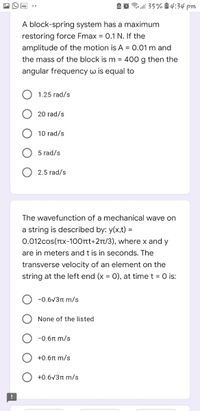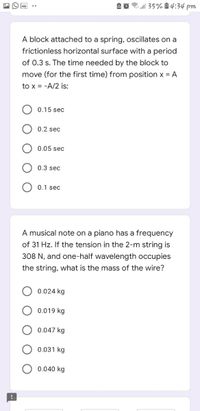
Elements Of Electromagnetics
7th Edition
ISBN: 9780190698614
Author: Sadiku, Matthew N. O.
Publisher: Oxford University Press
expand_more
expand_more
format_list_bulleted
Concept explainers
Question

Transcribed Image Text:A O 35%1 4:34 pm
A block-spring system has a maximum
restoring force Fmax = 0.1 N. If the
amplitude of the motion is A = 0.01 m and
the mass of the block is m = 400 g then the
angular frequency w is equal to
1.25 rad/s
20 rad/s
10 rad/s
5 rad/s
2.5 rad/s
The wavefunction of a mechanical wave on
a string is described by: y(x,t) =
0.012cos(TTx-100rt+21t/3), where x and y
are in meters and t is in seconds. The
transverse velocity of an element on the
string at the left end (x = 0), at time t = 0 is:
-0.6V3n m/s
None of the listed
-0.6n m/s
+0.6r m/s
+0.6v3n m/s

Transcribed Image Text:3 ll 35% à 4:34 pm
A block attached to a spring, oscillates on a
frictionless horizontal surface with a period
of 0.3 s. The time needed by the block to
move (for the first time) from position x = A
to x = -A/2 is:
0.15 sec
0.2 sec
0.05 sec
0.3 sec
0.1 sec
A musical note on a piano has a frequency
of 31 Hz. If the tension in the 2-m string is
308 N, and one-half wavelength occupies
the string, what is the mass of the wire?
0.024 kg
0.019 kg
0.047 kg
0.031 kg
0.040 kg
Expert Solution
This question has been solved!
Explore an expertly crafted, step-by-step solution for a thorough understanding of key concepts.
Step by stepSolved in 2 steps with 2 images

Knowledge Booster
Learn more about
Need a deep-dive on the concept behind this application? Look no further. Learn more about this topic, mechanical-engineering and related others by exploring similar questions and additional content below.Similar questions
- 4G VOWIF O 450 J A block-spring system has a maximum restoring force Fmax = 0.1 N. If the amplitude of the motion is A = 0.01 m and the mass of the block is m = 100 g then the angular frequency w is equal to 20 rad/s O 5 rad/s O 1.25 rad/s O 10 rad/s O 2.5 rad/sarrow_forwardConsider a spring-mass system with mass equal to 1 kg, spring constant equal to 25 Newton/meter.Which damping constant b causes critical damping?If the damping constant b in the above system is set to 3 N ∙ sec/m, then what can be said about the number of timesdoes the object pass through its equilibrium position?If the damping constant b in the above system is set to 8 N ∙ sec/m, then what is the interval of time between thesecond time the object returns to its equilibrium position and the third time it returns to its equilibrium position?arrow_forwardQ4\Find the type of damping in this system Where: m=5kg, K = 1500 /m N Damping coefficient= 1.5 *105 N-sec/marrow_forward
- 1- Two mass-spring-damper systems A & B. System A has = 0.1 and @n = 20 rad/sec, and system B has < = 0.3 and wn = 5 rad/sec. Which system will vibrate longer in time? Why?arrow_forwardA SDOF system with a mass 25 kg and stiffness 10 N/mm with damping 0.15 Ns/m is initially at rest. IF the inital velocity is 100 mm/sec. find the expression for subsequent displacement .Hence find displacement and velocity at t=2 secsarrow_forwardFind the natural frequency in Hertz of an undamped mass-spring system with a m= 100 grams and k= 100 N/marrow_forward
- Obtain X1(s)/F(s) and then determine the damping coefficient C of the mechanical system below. m2 =160.1 kg, k =953.7 N/m, k, =1,451.7 N/m, b, =148.0 N-s/m. X1(t) x2(t) k2 f2(t) m2 k, b2 massless plate Sonrakiarrow_forwardA mass-spring system is driven by the external force g(t) = 2 sin3t + 10 cos 3t. The mass equals 1, the spring constant equals 5, and the damping coefficient equals 2. If the mass is initially located at y (0) =-1, with initial velocity y' (0) = 5, find its equation of motion to find y (1). Round up the answer to the second decimal place point.arrow_forwardAn undamped single-degree-of-freedom system consists of a spring with stiffness k = 10 kip/in and a mass weighing W = 10 kips. The system is at rest and it is suddenly subjected to a half-cycle sine pulse force. The pulse force has an amplitude po = 1 kips and time duration td = 0.1 seconds. Calculate the maximum restoring force in the spring due to the pulse force.arrow_forward
arrow_back_ios
SEE MORE QUESTIONS
arrow_forward_ios
Recommended textbooks for you
 Elements Of ElectromagneticsMechanical EngineeringISBN:9780190698614Author:Sadiku, Matthew N. O.Publisher:Oxford University Press
Elements Of ElectromagneticsMechanical EngineeringISBN:9780190698614Author:Sadiku, Matthew N. O.Publisher:Oxford University Press Mechanics of Materials (10th Edition)Mechanical EngineeringISBN:9780134319650Author:Russell C. HibbelerPublisher:PEARSON
Mechanics of Materials (10th Edition)Mechanical EngineeringISBN:9780134319650Author:Russell C. HibbelerPublisher:PEARSON Thermodynamics: An Engineering ApproachMechanical EngineeringISBN:9781259822674Author:Yunus A. Cengel Dr., Michael A. BolesPublisher:McGraw-Hill Education
Thermodynamics: An Engineering ApproachMechanical EngineeringISBN:9781259822674Author:Yunus A. Cengel Dr., Michael A. BolesPublisher:McGraw-Hill Education Control Systems EngineeringMechanical EngineeringISBN:9781118170519Author:Norman S. NisePublisher:WILEY
Control Systems EngineeringMechanical EngineeringISBN:9781118170519Author:Norman S. NisePublisher:WILEY Mechanics of Materials (MindTap Course List)Mechanical EngineeringISBN:9781337093347Author:Barry J. Goodno, James M. GerePublisher:Cengage Learning
Mechanics of Materials (MindTap Course List)Mechanical EngineeringISBN:9781337093347Author:Barry J. Goodno, James M. GerePublisher:Cengage Learning Engineering Mechanics: StaticsMechanical EngineeringISBN:9781118807330Author:James L. Meriam, L. G. Kraige, J. N. BoltonPublisher:WILEY
Engineering Mechanics: StaticsMechanical EngineeringISBN:9781118807330Author:James L. Meriam, L. G. Kraige, J. N. BoltonPublisher:WILEY

Elements Of Electromagnetics
Mechanical Engineering
ISBN:9780190698614
Author:Sadiku, Matthew N. O.
Publisher:Oxford University Press

Mechanics of Materials (10th Edition)
Mechanical Engineering
ISBN:9780134319650
Author:Russell C. Hibbeler
Publisher:PEARSON

Thermodynamics: An Engineering Approach
Mechanical Engineering
ISBN:9781259822674
Author:Yunus A. Cengel Dr., Michael A. Boles
Publisher:McGraw-Hill Education

Control Systems Engineering
Mechanical Engineering
ISBN:9781118170519
Author:Norman S. Nise
Publisher:WILEY

Mechanics of Materials (MindTap Course List)
Mechanical Engineering
ISBN:9781337093347
Author:Barry J. Goodno, James M. Gere
Publisher:Cengage Learning

Engineering Mechanics: Statics
Mechanical Engineering
ISBN:9781118807330
Author:James L. Meriam, L. G. Kraige, J. N. Bolton
Publisher:WILEY